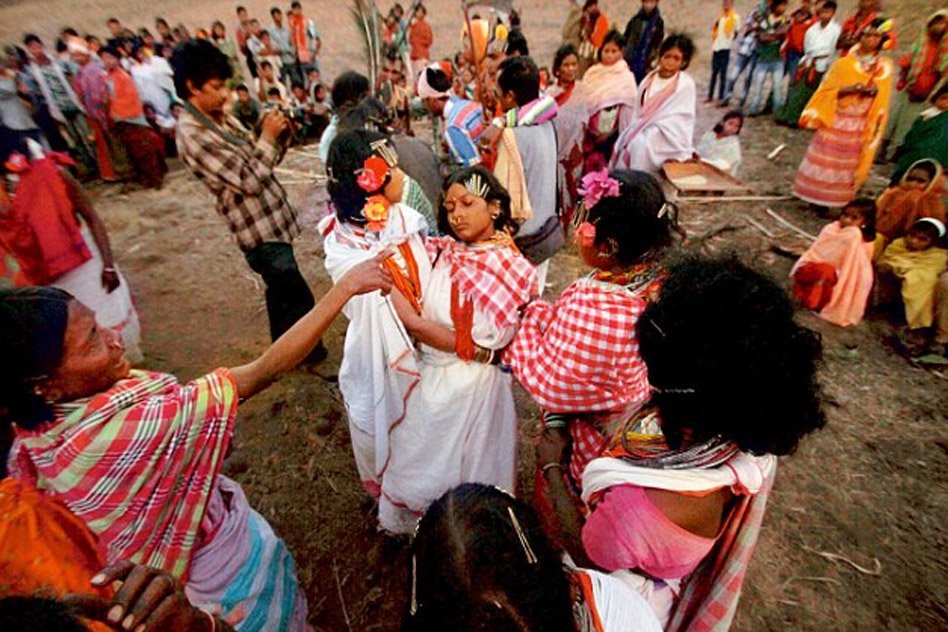
Patriarchy And Superstitions In Rural India Continue To Cause Death Of Women Branded As ‘Witches’
7 Feb 2017 6:43 AM GMT
Editor : Pooja Chaudhuri
The only fiction I enjoy is in books and movies.
In July 2015, Laila Orang, a 24-year boy from a village in Assam bid goodbye to his mother and left home at the usual time to work in the paddy field. When he returned at noon, he found the severed head of his mother lying centimetres away from her body, by the riverside.
A local mob had dragged Laila’s mother from her house, beat and stripped her, then beheaded her, as they believed she was a ‘witch’.
In August 2015, Usha Oaron’s mother-in-law was dragged by her hair, stripped naked and paraded at the village assembly point with three other middle-aged women who were beaten to death with iron rods. The incident occurred in a village named Kanjia in Jharkhand where the women killed were believed to have caused the death of a 17-year old boy from cancer by performing black magic on him. The mob, mostly comprising of 20-year-olds, called the women ‘witches’.
A group of people in December last year ganged up against an elderly woman in Nalanda district of Bihar, blackened her face, chopped off her hair and beat her up with sticks. The woman was accused of being a ‘witch’.
These are only three isolated incidents out of the 2,257 witch-killings in India since 2000.
“She is a devil in human form who survives on human blood and flesh. She has mastered jaadu-tona (black magic) and can burn you by just looking into your eyes.” – A woman from Rajasthan describes a witch.
It is 2017, but the widespread practice of witch hunting still prevails in the superstitious parts of rural India.
The practice involves the ‘Ojha’ or ‘Bej’ (witch-doctor) identifying ‘witches’. The ones who are lucky face stigmatisation and isolation from the village community. Others are subject to barbaric forms of torture – they are raped, physically abused, beaten, burned, paraded naked, force-fed human faeces and urine, and murdered.
Witch hunting prevails in India due to patriarchal attitudes and opposition to the rights of a woman. The victims are usually middle-aged or elderly widows or divorcees. Thus the motive of the murder is to rip her off her right to family land, property and money.
The National Crime Report Bureau (NCRB) report of 2015 placed Jharkhand first in witch-hunt with 32 murders, while Odisha was a close second with 26 murders. In total, there have been 133 cases in the country where the victims were murdered after being branded as ‘witches’.
Despite the Odisha Prevention of Witch Hunting Act, 2013 the State has continued to rank second for the past few years. Most cases are reported from the tribal regions. In 2015, six family members, including four children in Keonjhar district of Odisha were hacked to death by a local village mob after the family was accused of practising black magic. State Chief Minister, Navin Patnaik, said that the government is conducting awareness drives to combat the increasing number of cases.
According to the NCRB report, half of the total witch-killings in India is attributed to Jharkhand, Madhya Pradesh and Odisha. Between 2000 and 2012, there were 363 such murders in Jharkhand alone.
Is there any law which penalises witch-hunt and associated murders?
India does not have any national legislation to particularly penalise witch-hunt killings. Only the states of Bihar, Odisha, Jharkhand, Chhattisgarh, Assam, Maharashtra and Rajasthan, have specific State laws.
The Jharkhand Anti-Witchcraft Act 2001 makes the crime cognizable and non-bailable. However, a short jail term of 3 to 6 months with a penalty of Rs 1000 to Rs 2000 is hardly enough to mitigate such a deep-rooted menace which subjugates women for personal interests.
In contrast, the Chhattisgarh Witchcraft Atrocities (Prevention) Act, 2005 has stringent punishments. However, many cases remain pending in the State, and the life of victims after their perpetrators are punished remains tough, without compensation.
In 2013, Maharashtra had announced its progressive Anti-Superstition and Black Magic Act. The Rajasthan Prevention of Witch-Hunting Act 2015 imposes incarceration up to 7 years, extending up to life term, with a fine not less than Rs 1 lakh, or both.
The Logical Indian take
Even though laws exist in States that witness a maximum number of witch-hunt crimes, its ineffective implementation is the reason for the perpetuation of the practice. Underreporting of a large number of cases, ineffective legal investigation, inaccessible laws, futile rehabilitation process and lack of severe punishments add to the existing problem.
In an era where we are heading towards a greater modern society and progressive attitudes of communities, such superstitious practices only point to the lack of education and awareness among the citizens of our country. Reformative education is the building block for the progress of any society. Villagers visit witch-doctors because of ignorance and lack of proper health care. Support in this area is essential if a change is desired. Not only this, the gap between legislation and enforcement needs to be bridged manifold too.
 All section
All section













